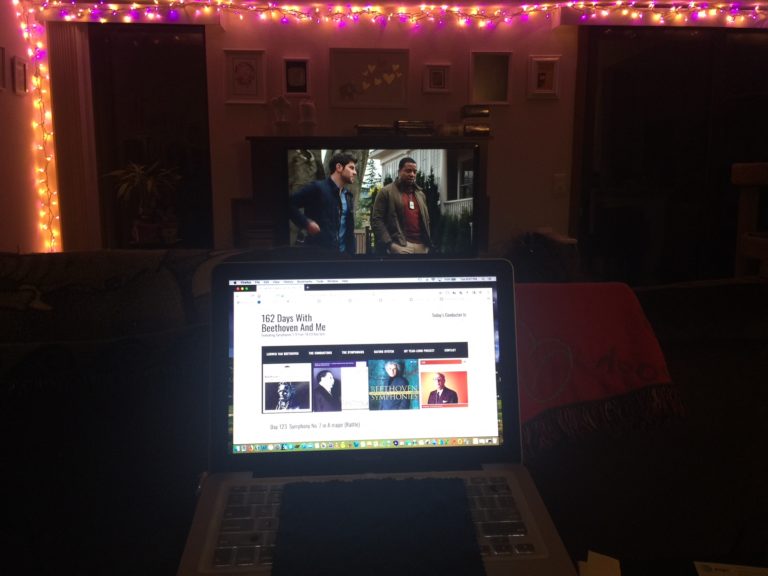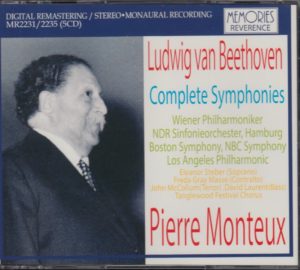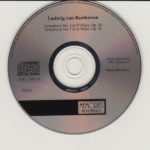
My listening post this evening is with the TV series Grimm in the background, a glass of Cabernet Sauvignon to my left, and a fresh page of a note pad to my right. (If you’ve never seen Grimm, you owe it to yourself. It’s a great cop show set in Portland, Oregon. It’s like a combination of the 1970s TV series Kolchak: The Night Stalker and the 1990s TV series The X-Files.)
In my earbuds is a performance by French-American conductor Pierre Monteux (1875-1964), the NBC Symphony, and Beethoven’s Symphony No. 7 in A major.
 I have encountered Maestro Monteux six times previous to this morning, on…
I have encountered Maestro Monteux six times previous to this morning, on…
Day 14. Rating: “Huzzah!”
Day 32. Rating: “Meh!”
Day 50. Rating: “Meh!”
Day 68. Rating: “Huzzah!”
Day 85. Rating: “Meh!”
Day 104. Rating: “Meh!”
Let’s see, that’s two “Huzzah!” ratings and four “Meh!” ratings.
What will this evening bring?
I’ll know in about 40 tape-hissy minutes.
First, I don’t think I’ve yet heard anything from the NBC Symphony Orchestra, although I’ve heard of it. So, from its entry on Wikipedia, I learned this:
The NBC Symphony Orchestra was a radio orchestra established by David Sarnoff, the president of the Radio Corporation of America, especially for the celebrated conductor Arturo Toscanini. The NBC Symphony performed weekly radio concert broadcasts with Toscanini and other conductors and served as house orchestra for the NBC network. The orchestra’s first broadcast was on November 13, 1937 and it continued until disbanded in 1954. A new ensemble, independent of the network, called the “‘Symphony of the Air'” followed. It was made up of former members of the NBC Symphony Orchestra and performed from 1954 to 1963, notably under Leopold Stokowski.
After the NBC Symphony Orchestra disbanded, some members went on to play with other orchestras, notably Frank Miller (principal cello) and Leonard Sharrow (principal bassoon) with the Chicago Symphony Orchestra. However, many former NBC Symphony members, in an attempt to stay together and preserve the orchestra, regrouped as a new ensemble called the “Symphony of the Air”.
The orchestra disbanded in 1963.
 Beethoven wrote his symphonies in four parts (except for the Sixth, which is in five). The time breakdown of this particular one (Symphony No. 7 in A major), from this particular conductor (Monteux, at age 78) and this particular orchestra (Boston Symphony Orchestra), at this particular time in history (November 15, 1953) on this particular record label (Memories Reverence) is as follows:
Beethoven wrote his symphonies in four parts (except for the Sixth, which is in five). The time breakdown of this particular one (Symphony No. 7 in A major), from this particular conductor (Monteux, at age 78) and this particular orchestra (Boston Symphony Orchestra), at this particular time in history (November 15, 1953) on this particular record label (Memories Reverence) is as follows:
I. Poco sostenuto – Vivace……………………………..14:10
II. Allegretto………………………………………………………8:25
III. Presto – Assai meno presto (trio)……………….8:28
IV. Allegro con brio…………………………………………..8:55
Total running time: 39:18
My Rating:
Recording quality: 3 (conspicuous tape hiss that, at times, obscures the music, lots of ambient noises, including what sounds like somebody bumping the device that holds the microphone – sort of like a table top or something like that)
Overall musicianship: 3 (seems to be a slightly brisker tempo than other performances to date)
CD liner notes: 0 (no liner notes – boo! hiss! – not even time indications: how long is each track?)
How does this make me feel: 2 (“Meh!”)
This is a very rough recording. The tape hiss is debilitating, especially on my beloved Movement II. There, the hiss obscures the music itself, making it frustratingly unlistenable.
Plus, it’s a mono recording.
What it sounds like is someone recording off their vinyl LP.
If that’s true, what we have is a recording from a mono TV in 1953, pressed into a vinyl record, then recorded off that.
I don’t know if that’s true or not. But that’s what it sounds like is going on.
To put it in perspective, this is like listening to the soundtrack to a movie from the 1930s. Something like The Adventures of Robin Hood.
Because of how it’s recorded, it’s hard to hear and appreciate this performance.
At best, this is a piece of history from a relatively famous conductor who fell into obscurity. At worse, this is horrible listening experience (yes, worse than Simon Rattle).
The only time when the orchestra’s performance overshadows the poor sonic qualities is Movement IV. There, I can hear the orchestra playing its ass off. The music is actually quite stirring. And impressive.
I can’t recommend this performance except for completists of a certain type of recording.
“Meh!”
